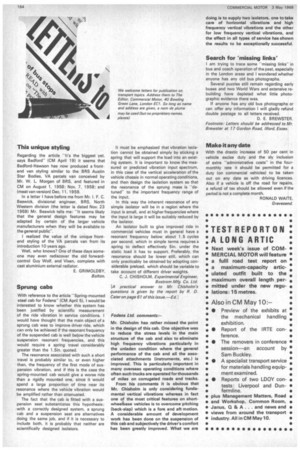Sprung cabs
Page 166

If you've noticed an error in this article please click here to report it so we can fix it.
With reference to the article "Spring-mounted steel cab for Fodens" (CM April 5), I would be interested to know whether this system has been justified by scientific measurement of the ride vibration in service conditions. I would have thought that the main object of a sprung cab was to improve driver ride, which can only be achieved if the resonant frequency of the suspended cab is well below the vehicle suspension resonant frequencies, and this would require a spring travel considerably greater than the 1.5in. quoted.
The resonance associated with such a short travel is probably similar to, or even higher than, the frequency of the first mode of suspension vibration, and if this is the case the spring-mounted cab would give a worse ride than a rigidly mounted one, since it would spend a large proportion of time near its resonance where the vehicle vibration would be amplified rather than attenuated.
The fact that the cab is fitted with a suspension seat substantiates this hypothesis; with a correctly designed system, a sprung cab and a suspension seat are alternatives doing the same job, and if it is necessary to include both, it is probably that neither are scientifically designed isolators.
It must be emphasized that vibration isolation cannot be obtained simply by sticking a spring that will support the load into an existing system. It is important to know the measured or predicted vibration input spectrum, in this case of the vertical acceleration of the vehicle chassis in normal operating conditions, and then design the isolation system so that the resonance of the sprung mass is -detuned" to the important frequency range of the input.
In this way the inherent resonance of any simple isolator will be in a region where the input is small, and at higher frequencies where the input is large it will be suitably reduced by the isolator.
An isolator built to give improved ride in commercial vehicles must in general have a resonant frequency below about 1.5 cycles per second, which in simple terms requires a spring to deflect effectively 5in, under the static load it has to support. Preferably, the resonance should be lower still, which can only practicably be obtained by adopting considerabie preload, which should be variable to take account of different driver weights.
C. J. CHISHOLM, Experimental Engineer, Bostrom Mfg. Co. Ltd. fA practical answer to Mr. Chisholm's questions is given by the report by R. D. Cater on page 61 of this issue.---Ed]




































































































































































































































